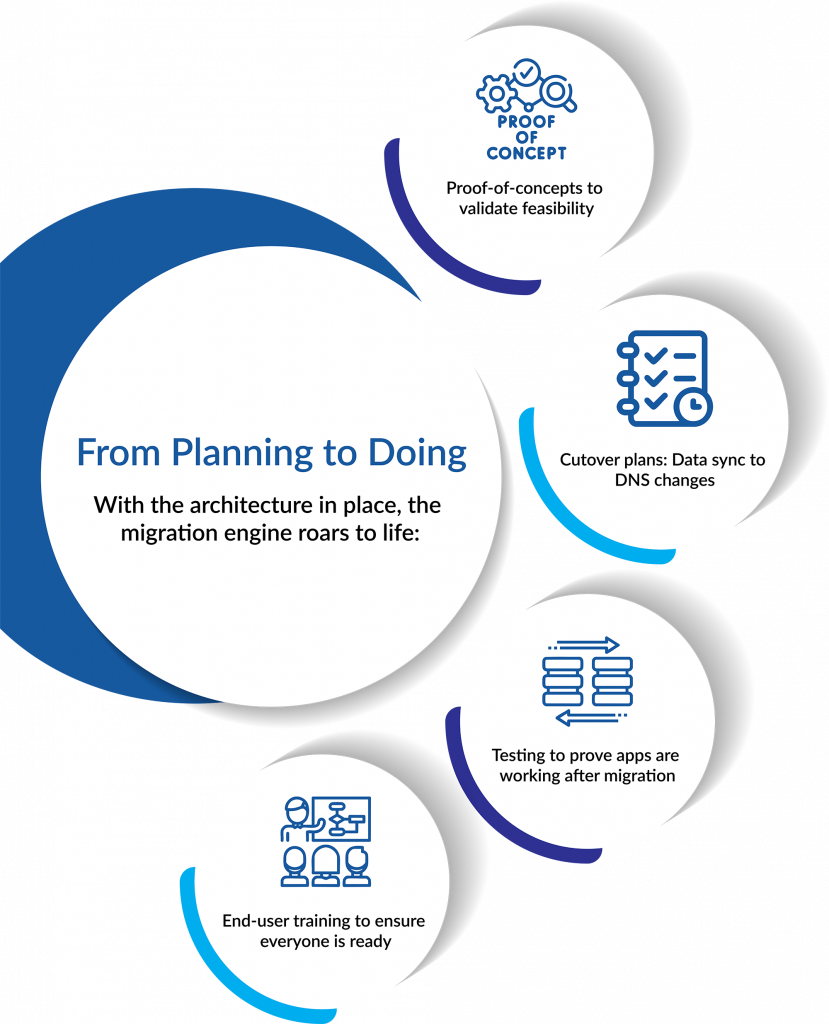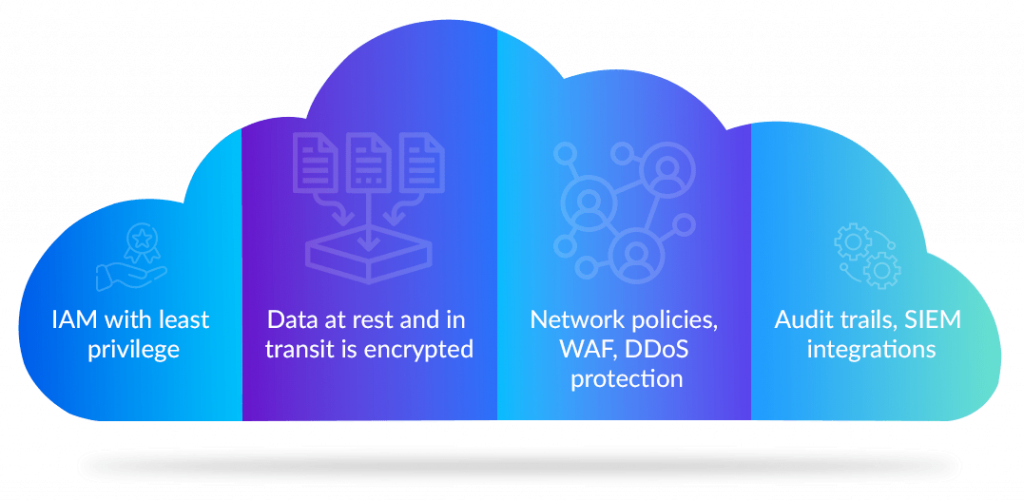
Here’s What You Will Learn in This Blog
- Search for the Why: Begin with the Purpose
- Finding a Path That Adds Up
- Discovering Hidden Dependencies
- Designing a Strong Foundation
- Resiliency Through Disaster Recovery
- The Vital Role of Middleware
- After the Move: Continuous Optimization
- Keeping Costs in Check
- A Success Story: The Transformation of Healthcare
- Integration with Oracle Cloud ERP Scenarios
- Securing Clouds: Governance and Compliance
- It’s Time to Act
- Let’s Dive Deeper
- Frequently Asked Questions (FAQs)
Picture yourself alongside a great digital ocean known as the cloud. And waiting in the wings is an opportunity horizon of resiliency, agility, cost-effectiveness, and innovation. But if you’re unprepared, the journey can be perilous. At Nsight, we lead organizations through the transformation journey when moving to the Oracle Cloud, transforming it from a leap of faith to a leap into the future.
Search for the Why: Begin with the Purpose
It starts with a question: What is driving your cloud migration? Perhaps it’s significant hardware refreshes, struggles with system performance, or a directive to modernize finance and supply chains. The return on investment for moving workloads to the cloud is high: IDC says that transitioning to the cloud can reduce infrastructure costs by 30–40% and enhance scalability, as well as business agility.
That was the case for one midsize manufacturer on the brink of data-center investment for the tipping point that became cloud migration, intent on cost and innovation control. Moving their ERP systems and analytics off-premises to Oracle Cloud, they no longer had the CAPEX burden of capital investment in infrastructure, they could scale up or down at will, and had the freedom to create AI and analytics capabilities, more often than not, every month versus every quarter or so.
Something like this doesn’t happen without executive buy-in and training throughout the entire organization. Being cloud-first is the team’s north star.
Finding a Path That Adds Up
Oracle Cloud also throws in force-migration for good measure—no plans to do a big bang?
Lift-and-Shift (Rehost): If you have legacy apps, then lift them onto VM instances in Oracle Cloud straightaway and enjoy no downtime, better infrastructure posture.
Replatform: Modernize applications with cloud native services — such as becoming cloud native with containerizing Java applications and moving to Oracle Kubernetes Engine — to achieve better scalability, availability, and cost.
Refactor or Re-architect: Rekindling Old Flames. Get the blueprints from old apps. Transition to a managed microservices approach with technologies like Autonomous Database, Functions, etc., and reduce maintenance overhead and improve performance.
Replace with SaaS: For HR, or Finance type modules, go to SaaS: Oracle Cloud ERP, Oracle HCM— bypass the Migrate, and move to fit-for-purpose SaaS.
The most common approach is to take a hybrid path. Retailers frequently rehost legacy systems while refactoring web-facing apps alongside a practical, phased path.
Discovering Hidden Dependencies
Have you ever seen an iceberg in a harbor? 80% of the mass is under the surface, and so are your system dependencies. A migration scan might return ETL pipelines, APIs, batch jobs, or file dependencies relating to apps that don’t appear to matter at first blush.
Some clients benefit from Nsight to untangle these “below-surface” dependencies. For one finance system migration, our tools revealed overnight reporting jobs and API connections, resulting in the decision to isolate the system and reduce post-migration downtime. Transparent planning now preempts surprises later.
Designing a Strong Foundation
This is where architecture enters the picture: Oracle Cloud provides strong building blocks, and it’s up to you to creatively construct with them.
Networking – Design separate VCNs for dev, test, and prod zones + secure VPN or FastConnect interlinks.
Identity & Access – Centralize with federated authentication.
Databases & Storage – Migrate to Autonomous Database or object storage as part of cloud-based DR plans with auto-snapshots and region failovers.
Monitoring & Governance – Enforce trackable policies with Budget, Cost Analysis, and Ops insights.
By combining Oracle’s infrastructure with clear tags and role assignments, you keep your cloud estate clean and manageable, and it’s all primed for performance enhancements.
Resiliency Through Disaster Recovery
High availability is not enough—planned failover is a must. Think about hardware failure, local downtime, or lost communication. By way of a pre-configured DR island with scheduled failover tests, having confidence in Oracle Cloud was built in.
Nsight clients — such as financial companies — build DR tests into the architecture. In a zone-wide outage, their system failed over automatically in minutes. Operations proceeded, patrons stayed online, and business continuity was golden. Or, DR is the lifestyle, not the afterthought.

The Vital Role of Middleware
The glory days of legacy apps are few and far between; they hardly ever work in isolation, and they need middleware. Oracle Fusion Middleware is invisibly working behind the scenes, binding it all together. But now, in the migration phase, it becomes visible.
In the last project, we were able to decouple the frontend of a legacy system using Oracle Service Bus and API Gateway. That way, we could park legacy apps for a while, while the front-end was still able to work consistently. Middleware isn’t optional—it’s mission-critical.
Zero Downtime Migration: A Strategic Imperative
Zero downtime migration to Oracle Cloud is not just a convenience—it’s a foundational requirement for enterprises with mission-critical workloads. Achieving this demands a meticulously engineered approach that preserves application continuity, safeguards data integrity, and deploys real-time failover mechanisms. A successful strategy hinges on designing phased cutovers, utilizing OCI-native migration and replication tools, and orchestrating transitions across hybrid or multi-cloud environments without interrupting business operations. Enterprises must also proactively manage dependencies, validate workload compatibility, and establish rollback safeguards to ensure a seamless shift to Oracle Cloud Infrastructure (OCI) with no service disruption.
After the Move: Continuous Optimization
Migration is only part one. So, where are the real wins?
● Move your databases to self-driving systems such as Oracle Autonomous DB
● Adopt Infrastructure-as-Code standardization
● Moving batch jobs into Functions/Streaming
● Introduce analytics monitoring
One client re-architected to run analytics on Autonomous Data Warehouse, reducing CPU usage by 40% and boosting performance by 3x. That’s cloud mojo.
Keeping Costs in Check
Cloud-unrestricted is budgetary chaos. Instead, set clear rules:
● Tag all resources
● Use cost alarms and budgets
● Leverage reserved instances
● Rightsize instances dynamically
● Pivot to serverless or container services (as activity stabilizes)
You can remain lean while keeping invoices light.
A Success Story: The Transformation of Healthcare
One health system was leveraging over 50 legacy systems, tin cans, and manual analytics—until Nsight made a difference. Together, we:
● Moved small VM app to Oracle Cloud
● Containerized clinical data interfaces
● Moved Lifespan of at least core analytics to ADW +OGG
● Shut down on-site servers entirely
Outcome? They cut infrastructure costs by 45%, accelerated analytics from hours to minutes, and entered real-time operations.
Integration with Oracle Cloud ERP Scenarios
Migration often intersects with SaaS moves. As clients migrated their core infrastructure, they concurrently deployed Oracle Cloud ERP. This allowed finance, procurement, and HR to tap into modern analytics streams—and easily scale for acquisition or divestiture actions. It’s a powerful signaling wave.
Curious how ERP scenarios look in practice? Read our deeper dive into Oracle Cloud ERP Use Cases to connect architecture with business impact.
Securing Clouds: Governance and Compliance
Security is not optional — it’s interwoven at every layer:

It’s Time to Act
“Oracle Cloud is prepared and ready and got its act together in 2023, and Gartner projects 75% of workloads to move by 2025,” Monash says. So why wait?
By embracing Oracle cloud migration strategies—including dependency mapping, DR planning, middleware orchestration, and cost management—you program the GPS to success. It’s more than just tech migration – it’s digital transformation insurance.
Let’s Dive Deeper
● Understand key cloud disaster recovery techniques for resiliency
● What is the middleware role in cloud migration, and how do services interact?
● See ERP in action with our Oracle Cloud ERP Use Cases gallery
When you’re ready to create a cloud journey with infrastructure, data, operations, and compliance in sync, we should talk. A short conversation now could shape your next 5 years of scaling success.
Frequently Asked Questions (FAQs)
Lift and shift, refactor to containers, re-architect in services, or replace with SaaS based on each workload’s objectives.
Lift-and-shift can be live in 4-8 weeks, while full re-architecture or ERP cloud typically spans 6-18 months, depending on complexity.
Good DR and dependency planning allow you to switch over in a short time–automating failover or doing a phased rollover.
It serves as a bridge and translator, allowing phased migration, Micro-Service deployment, and future-ready multi-cloud/hybrid-cloud integration across legacy and cloud systems.
Oracle Cloud comes with built-in controls; you have to set up tagged access, policies for encryption, and audit compliance. Nsight helps bridge this gap.
To be agile without breaking the bank, rely on disciplined tagging and reservation planning, rightsizing, and cost visibility.
If planned early, yes. DR isn’t just buttoned up and bolted on with backups or active-active DR zones; it is baked right into modern cloud strategy.
You may have brief training bumps, but with good documentation and Fiori-style design, UI transitions are low-friction.
Details like data residency, multi-region sync, and federated identity make it entirely possible, often beneficial for expansion strategies.
Begin with a readiness assessment — strategy apps, quantify goals, create a pilot. That is total transparency with minimal investment.
To Discover More – Connect with Our Experts Today!
About the Author

Aditya Mokkapati is a seasoned professional with more than two decades of experience in leading Oracle projects. Aditya has successfully managed multiple implementation, upgrade, and production support projects in Oracle Fusion and E-Business Suite across a wide range of industries, including manufacturing, hi-tech, and healthcare. He has worked closely with CXOs and business leaders, forging partnerships to offer the best solutions.





